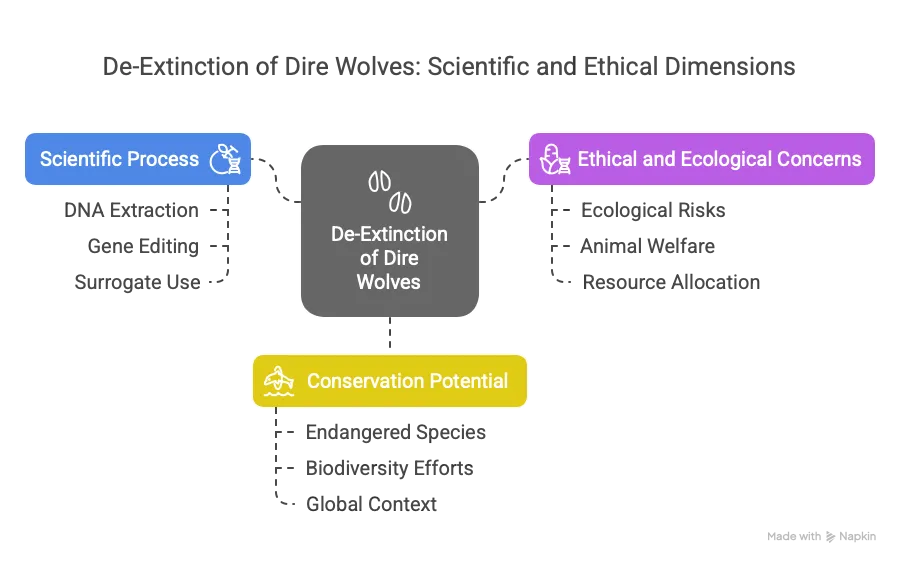UPSC
Indian Express Concise
De-Extinction of Dire Wolves: Science and Implications
Last Updated
9th April, 2025
Date Published
9th April, 2025
Share This Post With Someone


- Breakthrough Announcement: On April 7, 2025, Colossal Biosciences, a US-based firm, claimed to have revived the dire wolf, extinct for over 10,000 years, using genetic engineering.
- Process Explained: Scientists extracted DNA from a 13,000-year-old tooth and a 72,000-year-old skull, editing 20 genes in gray wolf DNA with CRISPR technology, then used surrogate dogs to birth three pups.
- Pups’ Identity: Named Romulus, Remus, and Khaleesi, these pups are not pure dire wolves but gene-edited gray wolves with dire wolf traits like larger size and white coats.
- Scientific Debate: Experts question if this is true de-extinction, as the pups share 99.5% DNA with gray wolves, suggesting they are hybrids rather than a fully revived species.
- Technological Feat: The use of ancient DNA and CRISPR highlights advancements in biotechnology, offering potential for conservation and species revival.
- Ecological Concerns: Reintroducing such hybrids into modern ecosystems poses risks, as their original Ice Age habitat no longer exists.
- Ethical Issues: The project raises questions about animal welfare, resource allocation, and the definition of species in genetic engineering.
- Conservation Potential: Colossal aims to apply this technology to preserve endangered species, enhancing biodiversity efforts.
- Global Context: This aligns with growing interest in de-extinction, seen in projects targeting mammoths and dodos, reflecting a shift in scientific capabilities.
- Future Implications: Success could redefine biodiversity management, but challenges remain in ensuring ecological balance and public understanding.
Glossary
- Dire Wolf: An extinct canine species (Aenocyon dirus) that roamed North America until about 10,000 years ago, larger than modern gray wolves.
- De-Extinction: The process of reviving extinct species using genetic engineering and cloning techniques.
- CRISPR: A gene-editing tool allowing precise modifications to DNA, used here to alter gray wolf genes.
- Gray Wolf: The closest living relative of the dire wolf, sharing 99.5% of its DNA, used as the base species.
- Ancient DNA: Genetic material extracted from fossils, providing insights into extinct species’ genomes.
- Surrogate: A host animal (here, domestic dogs) used to carry and birth genetically modified embryos.
- Biotechnology: The use of living systems and organisms to develop products, pivotal in this de-extinction effort.
- Hybrid: An organism with mixed genetic traits from two species, as seen in these pups.
- Biodiversity: The variety of life in an ecosystem, which this project aims to enhance.
- Ecosystem: A biological community of interacting organisms and their environment, potentially impacted by reintroduction.
Link To The Original Article – https://indianexpress.com/article/explained/explained-sci-tech/dire-wolves-de-extinction-colossal-9932402/